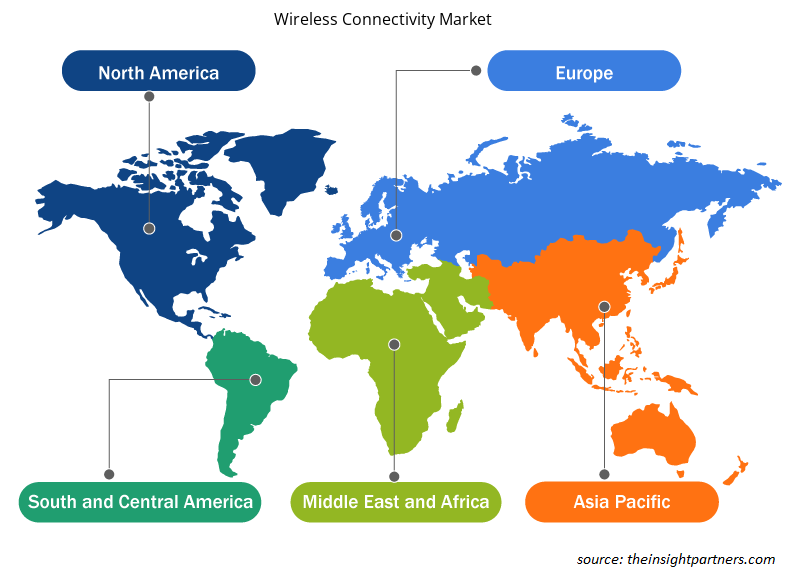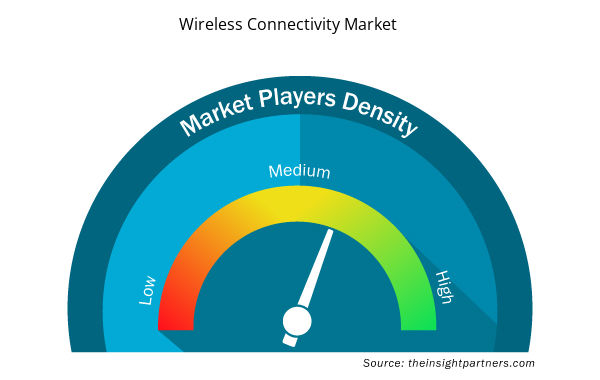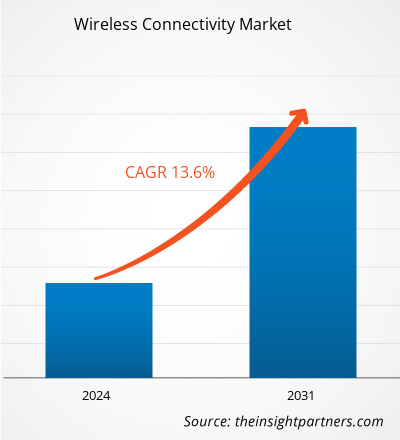Der Markt für drahtlose Konnektivität soll von 120,80 Milliarden US-Dollar im Jahr 2023 auf 335,96 Milliarden US-Dollar im Jahr 2031 anwachsen. Der Markt soll zwischen 2023 und 2031 eine durchschnittliche jährliche Wachstumsrate (CAGR) von 13,6 % verzeichnen. Der globale Markt für drahtlose Konnektivität soll im Prognosezeitraum aufgrund der steigenden Nachfrage nach Cloud-Computing und verwandten Technologien deutlich wachsen.
Marktanalyse für drahtlose Konnektivität
Darüber hinaus ermöglicht die drahtlose Konnektivität den Kunden, Daten mit besonders geringer Latenz zu senden und ihre Autos genau zu finden. Moderne Kommunikationsnetze wie LTE und LTE Advanced können zur Kommunikation mit intelligenten Autos genutzt werden. Intelligentes Fahren wird durch ein verbessertes 5G-Netz und das Internet der Dinge effizient gesteuert. Zahlreiche Fortschritte im Bereich der drahtlosen Kommunikation, darunter die bevorstehende Einführung von Long Term Evolution (LTE), die verstärkte Nutzung intelligenter Geräte, die erhöhte Mobilität und das schnelle Wachstum des mobilen Datenverkehrs, treiben die Nachfrage nach drahtloser Technologie voran . Neuere drahtlose Technologien erfordern mehr Energie und Spektrum. Die beiden am schnellsten wachsenden Mobiltechnologien sind LTE und 5G, und sie werden sich auch in Zukunft weiterentwickeln.
Marktübersicht für drahtlose Konnektivität
Die steigende Nachfrage nach Unterhaltungselektronik wird das Marktwachstum ankurbeln. Darüber hinaus wird erwartet, dass hochentwickelte Technologien wie KI, IoT, AR und VR in einer Vielzahl von Endverbraucherbranchen weiterhin beliebt bleiben. Die globale Entwicklung intelligenter Infrastrukturen ist auch ein wichtiger Treiber der Nachfrage nach drahtlosen Sensornetzwerken.
Infotainmentsysteme können über drahtlose Verbindungen wie WLAN und Bluetooth mit Smartphones und anderen intelligenten Geräten verbunden werden. Infotainmentsysteme können mit den Geräten der Benutzer gekoppelt werden. Sie können den Freisprechmodus nutzen, um während der Fahrt Anrufe anzunehmen, auf Sprachanweisungen zu reagieren und Systeme einfach und bequem zu bedienen.
Passen Sie diesen Bericht Ihren Anforderungen an
Sie erhalten kostenlos individuelle Anpassungen an jedem Bericht, einschließlich Teilen dieses Berichts oder einer Analyse auf Länderebene, eines Excel-Datenpakets sowie tolle Angebote und Rabatte für Start-ups und Universitäten.
- Holen Sie sich die wichtigsten Markttrends aus diesem Bericht.Dieses KOSTENLOSE Beispiel umfasst eine Datenanalyse von Markttrends bis hin zu Schätzungen und Prognosen.
Treiber und Chancen auf dem Markt für drahtlose Konnektivität
Hohe Internetdurchdringung begünstigt Markt
Die Internetdurchdringung in den entwickelten Ländern Nordamerikas und Europas hat im letzten Jahrzehnt dramatisch zugenommen. Laut Internet World Usage Statistics lebten im Jahr 2022 54,2 % der Internetnutzer in Asien und Europa und 66 % in Nordamerika. Der Nahe Osten und Afrika verzeichnen die höchsten Wachstumsraten bei der Internetnutzung. Die Internetnutzung auf Mobilgeräten nimmt zu. Da der Internetzugang immer wichtiger wird, steigt auch der Bedarf an drahtlosen intelligenten Geräten. In den nächsten fünf Jahren wird sich die weltweite Anzahl der Machine-to-Machine-Verbindungen (M2M) voraussichtlich mehr als verdoppeln. M2M-Verbindungen kommen in Lieferfahrzeugen von Fertigungsanlagen und in Lagerortungssystemen vor.
Steigende Nachfrage nach domänenübergreifenden Anwendungen
Um die drahtlose Technologie voll auszunutzen, sind bereichsübergreifende Fähigkeiten und Zusammenarbeit unerlässlich. Die IoT- und Cloud-Computing-Ökosysteme bieten Organisationen und Unternehmen exponentielle Entwicklungsperspektiven. Organisationen können auf aufkommende Cloud- und IOT-Trends sowie auf technologische Durchbrüche reagieren. Die Leistungsfähigkeit von Organisationen hängt von bereichsübergreifenden Beziehungen und Geschäftsstrategien ab. Huawei Technologies (China) hat LiteOS7 auf den Markt gebracht, ein neues Betriebssystem, das auf verschiedene Segmente wie tragbare Geräte, Smart Homes, das Internet der Fahrzeuge, intelligente Zähler und das industrielle Internet abzielt. Huawei Technologies (China) hat innerhalb des IoT-Ökosystems in mehrere Marktkategorien expandiert. Dies ermöglicht es der Organisation, eine Vielzahl von Anwendungen im IoT anzusprechen.
Marktbericht zur drahtlosen Konnektivität – Segmentierungsanalyse
Schlüsselsegmente, die zur Ableitung der Marktanalyse für drahtlose Konnektivität beigetragen haben, sind Technologie und Endnutzung.
- Basierend auf der Technologie ist der Markt für drahtlose Konnektivität in Wi-Fi, Bluetooth, Mobilfunk, ZigBee, GNSS und andere unterteilt.
- Basierend auf der Endnutzung ist der Markt für drahtlose Konnektivität in die Bereiche Industrie, Bau und Infrastruktur, Energie und Versorgung, Automobil und Transport, Gesundheitswesen, Verbraucher und Sonstige unterteilt.
Marktanteilsanalyse für drahtlose Konnektivität nach Geografie
Der geografische Umfang des Marktberichts zur drahtlosen Konnektivität ist hauptsächlich in fünf Regionen unterteilt: Nordamerika, Asien-Pazifik, Europa, Naher Osten und Afrika sowie Südamerika/Süd- und Mittelamerika. Der asiatisch-pazifische Markt wird voraussichtlich das schnellste Wachstum für drahtlose Konnektivitätssysteme erleben. Beispielsweise schätzt die US-China Economic and Security Review Commission, dass die staatlichen Investitionen in Smart-City-Initiativen in China in diesem Jahr 38,92 Milliarden USD erreichen werden. Das Wachstum der intelligenten Infrastruktur wird wahrscheinlich neue Möglichkeiten für drahtlose Kommunikationssysteme schaffen.
Regionale Einblicke in den Markt für drahtlose Konnektivität
Die regionalen Trends und Faktoren, die den Markt für drahtlose Konnektivität während des Prognosezeitraums beeinflussen, wurden von den Analysten von Insight Partners ausführlich erläutert. In diesem Abschnitt werden auch die Marktsegmente und die Geografie für drahtlose Konnektivität in Nordamerika, Europa, im asiatisch-pazifischen Raum, im Nahen Osten und Afrika sowie in Süd- und Mittelamerika erörtert.

- Erhalten Sie regionale Daten zum Markt für drahtlose Konnektivität
Umfang des Marktberichts zur drahtlosen Konnektivität
| Berichtsattribut | Details |
|---|---|
| Marktgröße im Jahr 2023 | 120,80 Milliarden US-Dollar |
| Marktgröße bis 2031 | 335,96 Milliarden US-Dollar |
| Globale CAGR (2023 - 2031) | 13,6 % |
| Historische Daten | 2021-2022 |
| Prognosezeitraum | 2024–2031 |
| Abgedeckte Segmente | Nach Technologie
|
| Abgedeckte Regionen und Länder | Nordamerika
|
| Marktführer und wichtige Unternehmensprofile |
|
Dichte der Marktteilnehmer für drahtlose Konnektivität: Die Auswirkungen auf die Geschäftsdynamik verstehen
Der Markt für drahtlose Konnektivität wächst rasant, angetrieben durch die steigende Nachfrage der Endnutzer aufgrund von Faktoren wie sich entwickelnden Verbraucherpräferenzen, technologischen Fortschritten und einem größeren Bewusstsein für die Vorteile des Produkts. Mit steigender Nachfrage erweitern Unternehmen ihr Angebot, entwickeln Innovationen, um die Bedürfnisse der Verbraucher zu erfüllen, und nutzen neue Trends, was das Marktwachstum weiter ankurbelt.
Die Marktteilnehmerdichte bezieht sich auf die Verteilung der Firmen oder Unternehmen, die in einem bestimmten Markt oder einer bestimmten Branche tätig sind. Sie gibt an, wie viele Wettbewerber (Marktteilnehmer) in einem bestimmten Marktraum im Verhältnis zu seiner Größe oder seinem gesamten Marktwert präsent sind.
Die wichtigsten auf dem Markt für drahtlose Konnektivität tätigen Unternehmen sind:
- Broadcom Inc.
- Cypress Semiconductor Corporation
- Intel Corporation
- Media Tek Inc.
- Microchip Technology GmbH
- NXP Semiconductors NV
Haftungsausschluss : Die oben aufgeführten Unternehmen sind nicht in einer bestimmten Reihenfolge aufgeführt.

- Überblick über die wichtigsten Akteure auf dem Markt für drahtlose Konnektivität
Neuigkeiten und aktuelle Entwicklungen zum Markt für drahtlose Konnektivität
Der Markt für drahtlose Konnektivität wird durch die Erhebung qualitativer und quantitativer Daten nach Primär- und Sekundärforschung bewertet, die wichtige Unternehmensveröffentlichungen, Verbandsdaten und Datenbanken umfasst. Im Folgenden finden Sie eine Liste der Entwicklungen auf dem Markt:
- Im Februar 2022 kündigte Verizon die Erweiterung seines Internetdienstes an, der es Kunden ermöglicht, im ganzen Land, darunter in über 30 Millionen Haushalten und mehr als 2 Millionen Unternehmen, auf zuverlässige, schnelle Plug-and-Play-WLAN-Internetdienste zuzugreifen.
(Quelle: Verizon, Unternehmenswebsite, 2022)
- Im August 2022 kündigte AT&T die Absicht an, seinen Glasfaser-Internetdienst auf Arizona auszuweiten. Die Verfügbarkeit soll 2023 erfolgen. Das Startup versprach, über 100.000 Haushalte in und um Mesa mit glasfaserbasierten Breitbandgeschwindigkeiten von bis zu 5 Gigabit pro Sekunde zu versorgen.
(Quelle: AT&T, Unternehmenswebsite, 2022)
Marktbericht zur drahtlosen Konnektivität – Abdeckung und Ergebnisse
Der Bericht „Marktgröße und Prognose für drahtlose Konnektivität (2021–2031)“ bietet eine detaillierte Analyse des Marktes, die die folgenden Bereiche abdeckt:
- Marktgröße und Prognose auf globaler, regionaler und Länderebene für alle wichtigen Marktsegmente, die im Rahmen des Projekts abgedeckt sind
- Marktdynamik wie Treiber, Beschränkungen und wichtige Chancen
- Wichtige Zukunftstrends
- Detaillierte PEST/Porters Five Forces- und SWOT-Analyse
- Globale und regionale Marktanalyse mit wichtigen Markttrends, wichtigen Akteuren, Vorschriften und aktuellen Marktentwicklungen
- Branchenlandschaft und Wettbewerbsanalyse, einschließlich Marktkonzentration, Heatmap-Analyse, prominenten Akteuren und aktuellen Entwicklungen
- Detaillierte Firmenprofile
- Historische Analyse (2 Jahre), Basisjahr, Prognose (7 Jahre) mit CAGR
- PEST- und SWOT-Analyse
- Marktgröße Wert/Volumen – Global, Regional, Land
- Branche und Wettbewerbsumfeld
- Excel-Datensatz



Report Coverage
Revenue forecast, Company Analysis, Industry landscape, Growth factors, and Trends

Segment Covered
This text is related
to segments covered.

Regional Scope
North America, Europe, Asia Pacific, Middle East & Africa, South & Central America

Country Scope
This text is related
to country scope.
Häufig gestellte Fragen
The global wireless connectivity market is expected to reach US$ 335.96 billion by 2031.
The key players holding the majority of shares in the global wireless connectivity market are Broadcom Inc., Cypress Semiconductor Corporation, Intel Corporation, Media Tek Inc., and Microchip Technology Incorporated.
Growing AI applications will lead to the incresing use of wireless connectivity to play a significant role in the global wireless connectivity market in the coming years.
High internet penetration rates are the major factors that propel the global wireless connectivity market.
The global wireless connectivity market was estimated to be US$ 120.80 billion in 2023 and is expected to grow at a CAGR of 13.6% during the forecast period 2023 - 2031.
Trends and growth analysis reports related to Electronics and Semiconductor : READ MORE..
The Insight Partners performs research in 4 major stages: Data Collection & Secondary Research, Primary Research, Data Analysis and Data Triangulation & Final Review.
- Data Collection and Secondary Research:
As a market research and consulting firm operating from a decade, we have published and advised several client across the globe. First step for any study will start with an assessment of currently available data and insights from existing reports. Further, historical and current market information is collected from Investor Presentations, Annual Reports, SEC Filings, etc., and other information related to company’s performance and market positioning are gathered from Paid Databases (Factiva, Hoovers, and Reuters) and various other publications available in public domain.
Several associations trade associates, technical forums, institutes, societies and organization are accessed to gain technical as well as market related insights through their publications such as research papers, blogs and press releases related to the studies are referred to get cues about the market. Further, white papers, journals, magazines, and other news articles published in last 3 years are scrutinized and analyzed to understand the current market trends.
- Primary Research:
The primarily interview analysis comprise of data obtained from industry participants interview and answers to survey questions gathered by in-house primary team.
For primary research, interviews are conducted with industry experts/CEOs/Marketing Managers/VPs/Subject Matter Experts from both demand and supply side to get a 360-degree view of the market. The primary team conducts several interviews based on the complexity of the markets to understand the various market trends and dynamics which makes research more credible and precise.
A typical research interview fulfils the following functions:
- Provides first-hand information on the market size, market trends, growth trends, competitive landscape, and outlook
- Validates and strengthens in-house secondary research findings
- Develops the analysis team’s expertise and market understanding
Primary research involves email interactions and telephone interviews for each market, category, segment, and sub-segment across geographies. The participants who typically take part in such a process include, but are not limited to:
- Industry participants: VPs, business development managers, market intelligence managers and national sales managers
- Outside experts: Valuation experts, research analysts and key opinion leaders specializing in the electronics and semiconductor industry.
Below is the breakup of our primary respondents by company, designation, and region:

Once we receive the confirmation from primary research sources or primary respondents, we finalize the base year market estimation and forecast the data as per the macroeconomic and microeconomic factors assessed during data collection.
- Data Analysis:
Once data is validated through both secondary as well as primary respondents, we finalize the market estimations by hypothesis formulation and factor analysis at regional and country level.
- Macro-Economic Factor Analysis:
We analyse macroeconomic indicators such the gross domestic product (GDP), increase in the demand for goods and services across industries, technological advancement, regional economic growth, governmental policies, the influence of COVID-19, PEST analysis, and other aspects. This analysis aids in setting benchmarks for various nations/regions and approximating market splits. Additionally, the general trend of the aforementioned components aid in determining the market's development possibilities.
- Country Level Data:
Various factors that are especially aligned to the country are taken into account to determine the market size for a certain area and country, including the presence of vendors, such as headquarters and offices, the country's GDP, demand patterns, and industry growth. To comprehend the market dynamics for the nation, a number of growth variables, inhibitors, application areas, and current market trends are researched. The aforementioned elements aid in determining the country's overall market's growth potential.
- Company Profile:
The “Table of Contents” is formulated by listing and analyzing more than 25 - 30 companies operating in the market ecosystem across geographies. However, we profile only 10 companies as a standard practice in our syndicate reports. These 10 companies comprise leading, emerging, and regional players. Nonetheless, our analysis is not restricted to the 10 listed companies, we also analyze other companies present in the market to develop a holistic view and understand the prevailing trends. The “Company Profiles” section in the report covers key facts, business description, products & services, financial information, SWOT analysis, and key developments. The financial information presented is extracted from the annual reports and official documents of the publicly listed companies. Upon collecting the information for the sections of respective companies, we verify them via various primary sources and then compile the data in respective company profiles. The company level information helps us in deriving the base number as well as in forecasting the market size.
- Developing Base Number:
Aggregation of sales statistics (2020-2022) and macro-economic factor, and other secondary and primary research insights are utilized to arrive at base number and related market shares for 2022. The data gaps are identified in this step and relevant market data is analyzed, collected from paid primary interviews or databases. On finalizing the base year market size, forecasts are developed on the basis of macro-economic, industry and market growth factors and company level analysis.
- Data Triangulation and Final Review:
The market findings and base year market size calculations are validated from supply as well as demand side. Demand side validations are based on macro-economic factor analysis and benchmarks for respective regions and countries. In case of supply side validations, revenues of major companies are estimated (in case not available) based on industry benchmark, approximate number of employees, product portfolio, and primary interviews revenues are gathered. Further revenue from target product/service segment is assessed to avoid overshooting of market statistics. In case of heavy deviations between supply and demand side values, all thes steps are repeated to achieve synchronization.
We follow an iterative model, wherein we share our research findings with Subject Matter Experts (SME’s) and Key Opinion Leaders (KOLs) until consensus view of the market is not formulated – this model negates any drastic deviation in the opinions of experts. Only validated and universally acceptable research findings are quoted in our reports.
We have important check points that we use to validate our research findings – which we call – data triangulation, where we validate the information, we generate from secondary sources with primary interviews and then we re-validate with our internal data bases and Subject matter experts. This comprehensive model enables us to deliver high quality, reliable data in shortest possible time.


 Holen Sie sich ein kostenloses Muster für diesen Bericht
Holen Sie sich ein kostenloses Muster für diesen Bericht